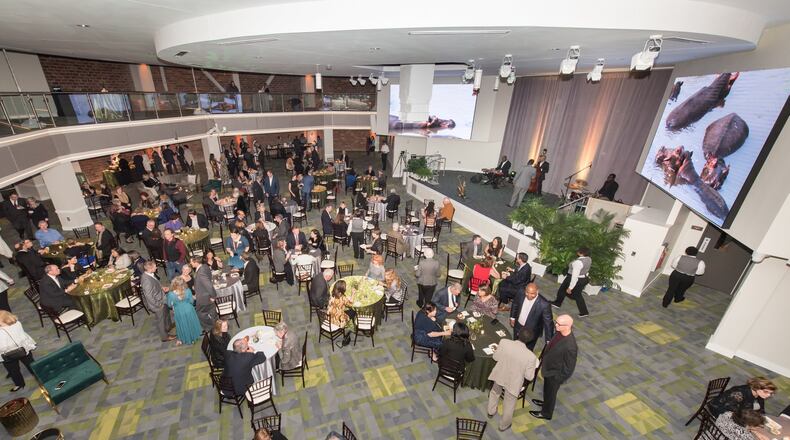Last Wednesday Rachel Davis, director of communications for Zoo Atlanta, stepped outside the third-floor ballroom of Savanna Hall, the zoo’s sparkling new events facility, and peered off the edge of the balcony into a scene of waterfalls and tropical plants.
"There's Msholo," she said. Striding across the landscape was the zoo's male elephant, his unhurried gait a combination of power, delicacy and 5.5 tons of grace.
Msholo was welcomed to Atlanta last summer when the ambitious expansion of the African Savanna habitat made room for additions to Zoo Atlanta’s elephant family. Now Msholo and his female companions, Kelly and Tara, are the floor show for Savanna Hall, which looks out over elephants, giraffes, zebras, meerkats and warthogs.
Savanna Hall, which held its first party Feb. 1, is a new incarnation for the Cyclorama building, built in 1921 to house the enormous cylindrical Battle of Atlanta painting.
In 2014, the city of Atlanta announced it would send that painting to the Atlanta History Center in Buckhead and put the Cyclorama building in the hands of the zoo. Consequently, the zoo developed a plan to renovate the Cyclorama building, create a new habitat for its elephants and a new entry plaza.
The builders ran into some difficulties. Zoo Atlanta president and CEO Raymond B. King said tariffs increased the price of steel, the foundation beneath the building was crumbling and had to be replaced and construction costs exceeded expectations, driving the price of the project from a proposed $38 million to $56 million.
The zoo planned to recoup some of that money with historic preservation tax credits, but those were slow in arriving, and the zoo had to take out loans to cover the shortfall. King said those loans should be paid off by the end of the second quarter.
Last fall the overruns, and other issues (including King's compensation package of almost $630,000) brought criticism from the Atlanta Fulton County Recreation Authority, which oversees the zoo.
Asked about that criticism before a press conference Wednesday, King said “We’re not going to go into that now. We’re here to celebrate the opening of Savanna Hall.”
The zoo already has about 75 events booked at the facility, with the expectation that there will be more, once clients have a chance to see the interior.
The space is being marketed for corporate events, meetings, banquets, proms, bar mitzvahs, weddings, parties and other gatherings. The first two floors house administrative offices for staff at the zoo.
It costs between $4,500 and $7,500 to rent the ballroom, with additional charges to use the dedicated caterer, Proof of the Pudding. The in-house caterer will have the use of two kitchens: A regular commercial kitchen and a kosher kitchen.
King said the facility should generate up to $1 million a year in income for the zoo. “We’ve created a destination like nowhere else in Atlanta,” he said.
The Cyclorama building was constructed in 1921 to display the 358-foot-long, 42-foot-high painting, the Battle of Atlanta, which was given to the city by Atlanta businessman George V. Gress. (Gress also donated the animals that became Zoo Atlanta.)
For the next 90-plus years Grant Park was home to the Cyclorama, which sat next to the zoo. The “Cyclorama” name is carved into a stone marker at the Cherokee Avenue entrance to Grant Park, and the words “Battle of Atlanta” are carved into Savanna Hall’s facade.
Some of this history is captured in an exhibit at the lower level entrance to Savanna Hall. The zoo gutted the interior and built a four-story building within the two-story Cyclorama building, keeping the terra cotta facing on the interior walls and the rail system that was used to hang the painting.
The exterior still looks the same, with the neo-classical columns at the entrance-way and the 10-sided exterior betraying the structure’s original purpose.
As designed in 1921, the building's 50-foot ceiling was supported by a single massive column at the center of the circular interior. During a radical 1979 renovation of the building (and the painting) under Mayor Maynard Jackson, the column was removed to create an unobstructed view, and replaced with trusses over the roof that supported the ceiling from above.
As a nod to the building’s history, an aperture in the ceiling of the newly-created 10,700-square-foot ballroom reveals the stubby remnant of that massive column.
King said the most important purpose of the facility is to bring a new group of people to the zoo — conventioneers, corporate clients and others — to expose them to the zoo’s collection and to galvanize support for the zoo’s conservation programs.
“It will bring people who have not thought of coming to the zoo before,” he said. “They will look out the window and say ‘This is not the zoo I grew up with, and I need to come back.’”
About the Author
Keep Reading
The Latest
Featured






